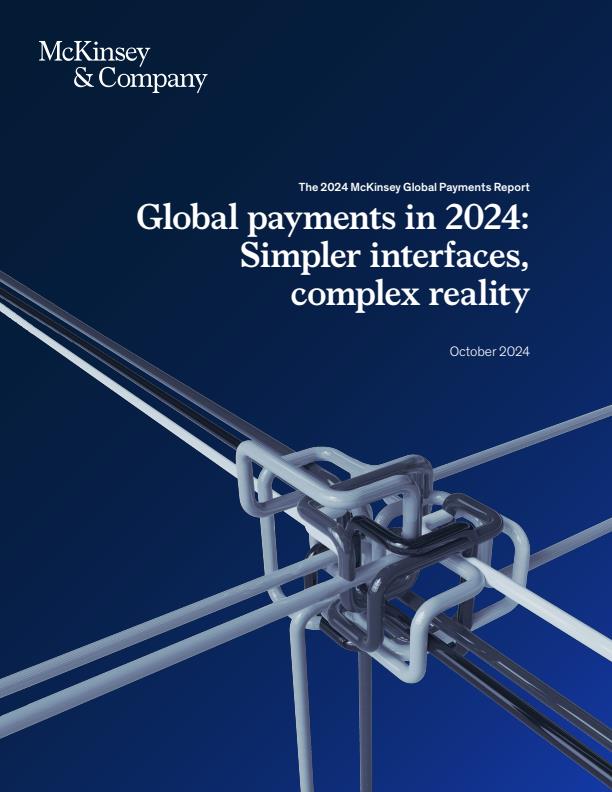The tantalizing vision for global payments has long been that they’d be safe, simple, quick, inexpensive, and ubiquitous. This promise has come closer with each new technological advance. However, instant payments have ushered in the Decoupled Era, a term coined in last year’s Global Payments Report. In this environment, payments are becoming disconnected from accounts, and the number of players is proliferating, fragmenting the value chain, increasing complexity, and endangering the vision.
This year’s report examines the evolving global payments ecosystem and highlights where players can capitalize on new dynamics. Our analysis is based primarily on McKinsey’s Global Payments Map, which covers more than 25 payment products in 48 countries and accounts for more than 90 percent of global GDP.
Global payments revenues will continue to grow
In 2023, the global payments industry handled 3.4 trillion transactions, accounting for $1.8 quadrillion in value and a revenue pool of $2.4 trillion. It grew 7 percent annually from 2018 to 2023, but our analysis suggests revenue growth will likely slow to 5 percent a year over the next five years. This will result in an additional $700 billion of revenue, for $3.1 trillion, by the end of 2028 (Exhibit 1). That’s 35 percent of the total banking revenue pool, a share that underlines the importance of banks investing in payment technologies to stay ahead of specialist players.

Six trends will define the next five years
Over the past decade, the combined market capitalization of specialist payments companies has increased from $400 billion to $1.4 trillion.1 In addition, more than 384 unicorns with a combined valuation of $1 trillion have emerged, a tenfold increase from 39 unicorns five years ago. These conditions set the backdrop for the six trends we expect will define the next five years.
1. The decline of cash will continue unevenly
Global cash usage now stands at 80 percent of 2019 levels and continues to decrease at 4 percent a year. The $26 trillion in payments still made in cash represents a massive opportunity for digitization, but the transition will unfold differently in different regions.
Instant payments are rapidly replacing cash in developing markets with low card penetration, such as India, Malaysia, and Indonesia.2 In India, the share is expected to decline from 23 percent of consumer spending to less than 10 percent by 2028.
In card-dominated markets such as the United States, where cash transactions represent just 5 percent of the value of consumer payments, cash usage will continue the gradual decline initiated by the COVID-19 pandemic. The decline will also continue gradually in developed economies with a strong cultural preference for cash, such as Germany and Japan.
2. Instant payments will continue to displace other payment methods
Real-time payments infrastructures have now been established in almost every major market, and we believe they will accelerate the phasing out of cash and checks.
In card-concentrated markets, such as the United Kingdom and the United States, instant payments will not easily displace cards. In historically cash-heavy markets, such as Brazil and India, instant payments will likely capture C2B share over the next few years. In these markets, regulatory mandates have enabled interoperability, which—combined with more competitive merchant propositions and compelling consumer offerings, including higher transaction limits and wider availability—is helping instant payments gain share.
We expect similar interventions in the European Union to boost adoption there. We estimate that the number of instant-payment transactions in the European Union will increase from around three billion today to almost 30 billion by 2028, an average annual growth rate of 50 percent.
3. Growing adoption of digital public infrastructures will catalyze digital payments
Digital public infrastructure (DPI) initiatives in markets like Brazil, Estonia, and India have supported competitive, robust, inclusive, and efficient digital payments ecosystems. Critical prerequisites for a DPI are a comprehensive digital ID system, common standards for application interfaces, interoperability among financial services providers, and the inclusion of nontraditional data sources.
We expect to see a broader rollout of DPI initiatives in emerging markets like Indonesia, Nigeria, and Peru through a combination of imported technology, such as India’s DPI solution, and domestic builds, such as the Singapore Financial Data Exchange. Developed economies without such initiatives may be constrained in their ability to combat fraud or support the digitization of services.
4. Intermediaries will continue to take share from incumbents
Commerce is aggregating onto platforms such as Shopify, Square, and Toast, as well as marketplaces like Amazon, eBay, and Etsy. We estimate that platforms and marketplaces process 30 percent of global consumer purchases today (Exhibit 2). The share is higher in the small and medium-size enterprise (SME) segment, where players including Square, SumUp, and Toast offer integrated solutions.

McKinsey survey data shows that vertical-specific software solutions captured more than 50 percent of SME spending in 2023 in the United States. Incumbent scale acquirers and banks are responding with their own ISV solutions, such as Clover from Fiserv and Talech from Elavon, a subsidiary of U.S. Bank.3
On the enterprise side, digital-native merchants like Airbnb and Netflix are growing more rapidly than their offline counterparts, capturing a larger share of total commerce and driving down acquiring fees.4 They are turning to modern global acquirers such as Adyen and Stripe, thereby increasingly relegating traditional acquirers to commoditized payment processing.
5. Transaction banking will mimic consumer experiences
In recent years, transaction banking has become a differentiator for leading institutions, capturing a larger share of revenues and strengthening client relationships. Some, such as Santander with its PagoNxt offering, have taken steps toward running payments as stand-alone businesses.5 Others, such as Goldman Sachs and Royal Bank of Canada, have launched new transaction banking business units.6
We expect commercial customers of transaction banking services to demand and receive intuitive interfaces like those they encounter in their personal lives. Meanwhile, technological advances will help solve reconciliation problems and streamline supply chain finance with faster and deeper integration of bank and corporate systems. As competition for this business increases, including from disrupters, corporates should see a substantial improvement in functionality and user experience in the corporate back office.
6. CBDCs will set the baseline for digital currencies
More than 90 percent of central banks are pursuing or considering central bank digital currency (CBDC) projects, and more than 30 have rolled out pilots.7 However, the initial excitement about the disruptive potential of CBDCs has waned, given its limited uptake so far.
Nonetheless, we foresee CBDCs playing three roles in payments: First, they will set the minimum base level of functionality, cost, and services that users can expect from a digital currency. Second, they will provide an alternative to help keep the price of commercial offerings in check. And finally, they will serve as an alternative to large but often opaque private-sector stablecoins.
Capturing the next $1 trillion in growth
We see three main areas where operators and disrupters will want to invest to capture their share of market growth: instant payments offerings in margin-rich segments where they have the ability to succeed; improvements to anti–money laundering (AML) and fraud prevention systems; and infrastructure and systems that can operate reliably at high volumes.
Deciding where to play in instant payments
Instant payments enable innovation in every retail and corporate segment. Of these, cross-border payments; treasury management, comprising accounts receivable (AR) and accounts payable (AP); and payouts, refunds, and payroll are particularly attractive.
Cross-border payments. Various international initiatives, including Project Nexus from the Bank for International Settlements, create opportunities for payments players to lead with distinctive new capabilities, such as mobile-first cross-border remittances in retail or international trade platforms for SMEs. Early leaders include disrupters such as Wise for retail and Airwallex for SMEs, and global banks such as DBS with Globesend, and HSBC with Global Disbursements.
Adoption is growing quickly. For instance, 23 percent of UK SMEs regularly use fintechs and other nonbank providers for their cross-border payments—significantly higher than the 13 percent for domestic transactions.8 The proportions are higher for smaller concerns, accounting for 30 percent of cross-border transactions for micro businesses (Exhibit 3).

Treasury management (AR and AP). CFOs’ pain points include limited real-time visibility of global transactions, manual payment reconciliations, and non-standardized invoice processing.
Banks that want to maintain ownership of critical client relationships, must navigate developing and packaging their SME and corporate offerings. This will require deciding which services to build in-house, identifying potential partners for specialized solutions, and possibly orchestrating a network of partnerships to stay relevant and competitive.
Payouts, refunds, and payroll. Employers can enhance worker satisfaction and retention by facilitating immediate compensation, particularly in the gig economy, where rapid access to earnings is crucial. Ride hailing firms have leveraged traditional and instant payment rails to allow drivers to cash out instantly. Instant payments can allow companies to enhance customer satisfaction and loyalty; merchants can immediately credit customers’ bank accounts for product returns, and insurers can provide immediate payouts for claims. Being the first to market these solutions can be a significant differentiator for payments players that can grasp the opportunity.
Prioritizing the fight against financial crime
Global losses from payment card fraud are projected to reach $400 billion over the next ten years, with authorized push payment fraud alone expected to grow at 11 percent CAGR from 2023 to 2027.9
Regulators are moving to drive customer protection liability to providers and increasing pressure on banks and other players to fight money laundering; AML fines hit a record high of more than $6 billion in 2023.10
To prepare for the future, players will likely need to invest in complying with emerging regulations for real-time or near-real-time fraud detection and prevention, including payee verification and screening for sanctions. This will require upgrading customer authentication methods, including step-up and voice authentication, and participating in consortia to integrate data such as real-time biometrics, GPS location, and IP address. We have also seen interesting experiments with AI trained on transaction data and users’ financial and social data to better detect fraud and money laundering with fewer false positives.
Investing in the next generation of payments infrastructure and technology
Regulators are intensifying their demands for faster, more efficient payment processes that maintain low costs for consumers and businesses. Instant payments will require clearing and settlement infrastructures that can operate at high volumes and enable reconciliations, dispute resolutions, and refunds in real time. They will also need features like 24/7/365 availability and enhanced fraud prevention. Also, because real-time transactions connect with most other technological and operational components, players will want to ensure that their entire business architecture supports the transition.
Saddled with systems they developed decades ago, many incumbents find it hard to respond quickly to such demands. However, some, such as Goldman Sachs and RBC, have shown they can mimic the speed and agility of disrupters with client-backed approaches, launching new businesses in under two years.
Much still to do, but the goal is in sight
We expect that increasing system complexity and regulatory pressure will fuel three trends that will characterize the future payments landscape: further market consolidation, increased orchestration of payments, and more regulatory action to reduce costs and financial crime while increasing consumer protections and reliability.
Global payments are not yet ubiquitously safe, simple, quick, and cheap. But the goal is in sight, and the industry is making progress on many fronts at once.


